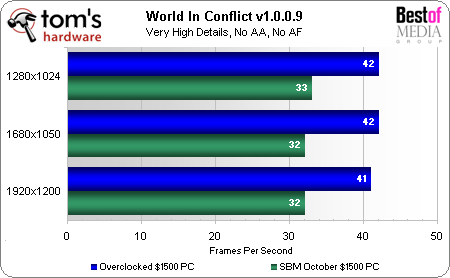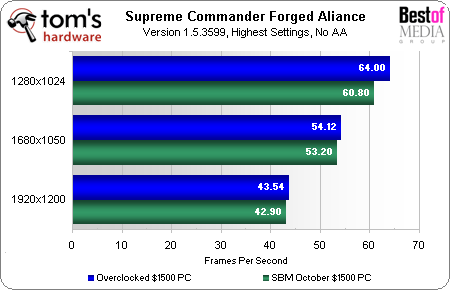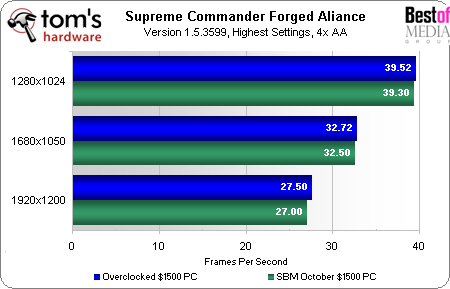Tom's SBM: The $1,500 Mainstream PC
Game Benchmarks: Real-Time Strategy

World in Conflict is a new addition to our benchmark suite, as a visually demanding real time strategy game. It’s gorgeous, and the mid-range system handles it very well. Resolution doesn’t seem to have much of an impact on performance here, indicating a bottleneck somewhere, probably with the CPU. CPU bottlenecking is further supported by the 30% performance increase we see when overclocked.

The difference between an average of 30 fps and 40 fps in a video game can be quite dramatic, as the frame rates are low enough at this level for the change to be noticed. As frame rates approach 60, though, it’s more difficult to see any difference in the smoothness of the video, so this is one case where the overclock should provide a noticeable boost.
Now let’s look at how the system holds up with 4x anti-aliasing and 16x anisotropic filtering applied:

Wow, the frame rates barely nudge at all. This is absolute proof that the game is CPU bottlenecked, as this option will put a much higher load on the video cards, yet the frame rates are almost identical.

Supreme Commander: Forged Alliance is the new Supreme Commander expansion, with newer units, enhanced visuals, and the same system-punishing requirements. Notice how as the resolution is raised, performance suffers, yet the overclocked system doesn’t seem to do much better; this indicates the opposite of a CPU bottleneck, likely a graphics card bottleneck.

With anti-aliasing applied, the system once again slows, and we see that the high CPU overclock is doing nothing for performance. There is a tiny speed increase, which is likely due to the small video card overclock.
Current page: Game Benchmarks: Real-Time Strategy
Prev Page Game Benchmarks: First-Person Shooters Next Page ConclusionGet Tom's Hardware's best news and in-depth reviews, straight to your inbox.
Don Woligroski was a former senior hardware editor for Tom's Hardware. He has covered a wide range of PC hardware topics, including CPUs, GPUs, system building, and emerging technologies.
-
Hi,Reply
This is my first comment although I have reading this website for the past 8 years. Anyway to th point - Usuallt I agree 90% with you on components you choose, especially in the high-end and budget configuration. But this time a lot of tings strikes me: First it is the CPU - I am pleased You have addressed the issue to a great degree in the article later, but still I think it will be appropriate to try to further increase the voltage because this is a watercooled 65nm CPU; Second the chipset I think it`s ot the best choise, X38 is a former high-end chipset so when You`re overclocking you should get the faster binned X48, but because this is mid-range configuration I think it`s best to taka advantage of the super popular P45; Third the motherboard I am not sure if a motherboard with a not so stron PWM is the best tool for overclocking such a power-hungry chip, You should try to overclock on a different motherboard to see why are yuo`re not receiving a more descent overclock;Forth and last the price difference to a 1066MHz kit is pretty small so I think it`s preferable because tis will give You flexibility to try higher FSB with lower multiplier, wchich should give another notch of performance. I am saying all this because I want to help You make this website even better.
Best Regards. Bobby -
I think it would be interesting to see power consumption and noise benchmarks for the PCs you build in this article series.Reply
-
JeanLuc I can see why you wanted to use a water cooling kit so that you got the best possible overclock from the CPU but water cooling is hardly ‘mainstream’ which is what I thought this system builder marathon was all about. The same goes for the choice of motherboard, the X38 is an enthusiast’s motherboard, something like the Biostar T Power i45 would have been more appropriate and according to CustomPC UK is just as good at overclocking as any other motherboard.Reply
Good choice in video cards, I’m glad you didn’t choose 4850’s with the stock coolers because those bad boys run really hot.
-
Proximon Well it was a good try. Would have preferred a more truly mainstream rig, but then the forums are full of those.Reply -
fallen2004 P45 wouldnt have workd cos it would bottleneck the crossfire as it only runs at 8x and 4850's need 16xReply -
neiroatopelcc JeanLucI can see why you wanted to use a water cooling kit so that you got the best possible overclock from the CPU but water cooling is hardly ‘mainstream’ which is what I thought this system builder marathon was all about.Reply
I agree with this dude really. Anything watercooled is enthusiast, not mainstream. I don't know if americans just treat themselves to better hardware, but here in europe anyone with watercooling is considered an enthusiast. Nobody with a reasonable budget is going to 'waste' money on water cooling. Imo a tuniq, tr120 or a scythe something cooler would've been a more appropriate midrange guess. Also I'd expect anyone building a pc today to pick a p45 over an x38 (though I like the red slots on this one) -
neiroatopelcc fallen2004P45 wouldnt have workd cos it would bottleneck the crossfire as it only runs at 8x and 4850's need 16xBtw I'm running a 4870 on an x16 pcie v1 - that equals an x8 pcie v2 connection. And I can hardly claim that my system's limited by the bandwidth.Reply -
dirtmountain A E8500, single socket P45, HD4870x2,Sunbeam core contact cooler and a Coolermaster 690 would have made their budget and blown the socks off that build.Reply -
grumps01 How about some info on this "mainstream" system sound wise. How Loud or quite is this system use this Swiftech H20-220 Kit with larger pumps etc. Also what's the temperatures like (heat dissipation) like in general with this combination please?Reply
I know most ppl are probably more interested with the benchmarks, but I'm sure this might interest some people on what's it like to live with, thanks!